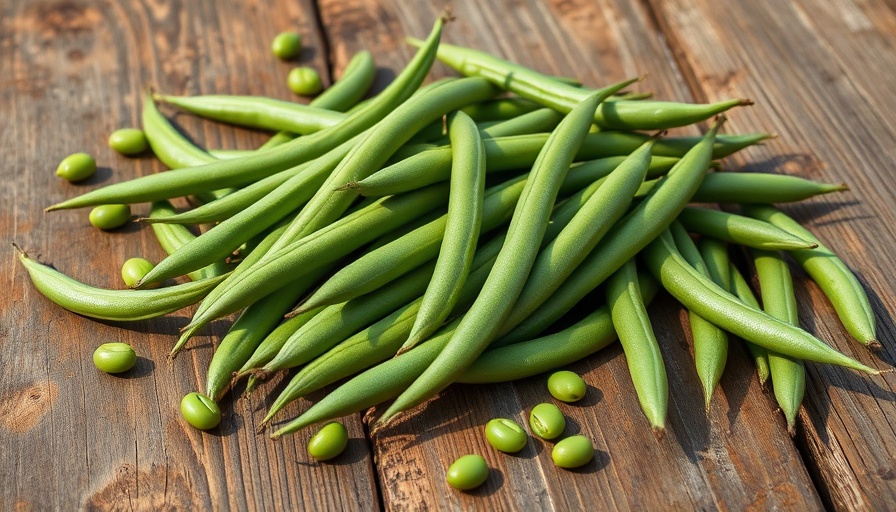
Discovering Rattlesnake Pole Beans: A Gardener's Delight
Rattlesnake pole beans (Phaseolus vulgaris) are more than just a visually captivating addition to your garden. These heirloom beans are well-known for their vigorous growth and high yields, making them a favorite among gardeners looking for something both beautiful and delicious. Not only do the dark green pods showcase stunning purple stripes reminiscent of a rattlesnake's skin, but they also offer versatile culinary uses.
Easy to Grow: Your Guide to Planting Rattlesnake Beans
As a home gardener, what could be better than a resilient and productive plant? Rattlesnake pole beans thrive when directly seeded in your garden beds or containers. Their tall, vining nature means you can capitalize on vertical gardening, taking up minimal ground space while growing upwards of 8 to 10 feet tall. Make sure to plant them in locations that receive at least 6 to 8 hours of sunlight daily, and ensure the soil temperature sits at a warm 60 degrees Fahrenheit (15 degrees Celsius) before sowing your seeds.
Timing your planting correctly is essential. It’s advisable to wait until after the last frost before planting. From seed to harvest, plan for approximately 65 days—making them an excellent summer crop. To prolong your harvest, consider succession planting, where you sow a second round of beans about a month after the first. This technique not only extends your harvest window but also ensures a continuous supply of fresh beans throughout the summer.
How to Successfully Support Your Beans
Unlike bush beans, rattlesnake pole beans require effective support structures to thrive. Various options can accommodate their climbing habit, such as A-frame trellises, vertical trellises, or even simple teepees constructed from garden stakes. The key is to set up these supports before planting to avoid disturbing the young plants later on.
When planting, consider spacing your seeds about three inches apart and an inch deep, carefully situated at the base of your chosen support. By giving your plants room to grow, you’ll create an environment that maximizes their yield while simplifying maintenance.
Caring for Your Rattlesnake Pole Beans
Rattlesnake pole beans are renowned for their low maintenance needs. Once they've germinated, your primary job is to keep the soil consistently moist without overwatering. These beans are not only forgiving but are also nitrogen fixers, helping to enrich your soil for future planting endeavors.
Some gardeners choose to inoculate their seeds with beneficial microbes to enhance growth further. This step, while optional, can lead to even more substantial yields. Keeping the area weed-free and providing adequate water during dry spells will ensure your plants remain healthy and productive.
Harvesting Tips: When to Pick Your Beans
Timing is crucial when it comes to harvesting your rattlesnake pole beans. For the best taste, aim to collect the pods when they reach between 5 to 8 inches in length. At this stage, the beans are still tender and ideal for cooking or eating fresh. With a harvest window that can last for five to six weeks, these beans will provide you with ongoing rewards throughout the summer months.
Embrace the Visual Beauty: Beans That Please the Eye
One of the undeniable joys of growing rattlesnake pole beans is not merely the flavor but also their striking appearance. The patterned pods add an aesthetic appeal to your garden, elevating the visual experience. Additionally, even the matured beige seeds with dark spots offer another level of beauty, perfect for saving and sharing with fellow gardening enthusiasts.
Conclusion: A Rich Addition to Your Gardening Journey
As you embark on your journey of growing rattlesnake pole beans, remember the rewarding experience that awaits. From the delightful ease of planting to the vivid visual glory they bring to your garden, these beans are a wonderful way to engage with the earth. Consider succession planting for a continuous harvest, and enjoy the multifaceted rewards as you cultivate, care for, and consume.
Ready to enhance your garden this summer? Spice things up with some rattlesnake pole beans and watch your vegetable garden flourish!
 Add Row
Add Row  Add
Add 


Write A Comment